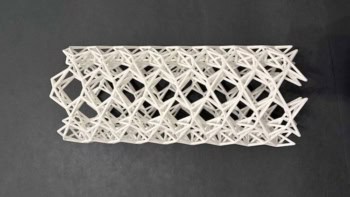
A new mechanoluminescent material can store information about mechanical events it experiences and then divulge its history under a laser “spotlight” as many as three days later. Demonstrated by Philippe Smet and colleagues at LumiLab, part of Ghent University in Belgium, the material derives its long memory from excited electrons that are trapped within defects in the material’s crystal lattice. The team’s findings could have several applications, including new ways to record damage to components or structures.
Mechanoluminescent (ML) materials emit light when they are subjected to mechanical stresses and deformations such as fracturing, bending, and compression. In some materials, ML effects can be induced by first irradiating the material with blue or ultraviolet light. While many of the electrons excited by this light will release their energy immediately, a fraction will become trapped in higher-energy states associated with defects in the material’s crystal lattice. Then, when the material experiences a mechanical stress, the trapped electrons return to their luminescent centres, emitting photons in the process.
This property could be useful for many applications, including pressure sensing and damage detection. However, because these ML materials emit light only when pressure is applied, materials used for such purposes must be monitored continually.
A range of trap depths
This shortcoming has hindered the development of ML materials, but Smet’s team got around it thanks to a ML crystal that contains defects with a wide range of trap depths. In this material, which has the chemical formula BaSi2O2N2:Eu2+, mechanical stresses push some of the excited electrons into deeper traps where they can be stored almost indefinitely – essentially “writing” information about the material’s history into its crystal structure. These deeply-trapped electrons can only escape and emit photons when they are subjected to infrared radiation, meaning information about past stresses can be “read out” optically.
To demonstrate the pressure-memory effect, Smet and colleagues dragged a rod across a sample of the material, then measured its luminescence after irradiating it with an infrared laser at different times. They found that the material’s memory of the location and intensity of the mechanical stress endured for more than three days. For the first time, this showed that mechanical actions can lead to a reshuffling of trap occupations in ML materials.
Smet and colleagues envisage that their memorable ML material could have applications in detecting damage to buildings, vehicles, and other structures for which continuous monitoring is impractical. Their findings could also inform studies of how charge carriers move into different types of defect within luminescent crystals, with further applications potentially including efficient LEDs and better glow-in-the-dark coatings. In future studies, the LumiLab team hope to improve the sensitivity of their material to optimize its memory storage and readout capabilities.
The researchers report their work in Light: Science & Applications.



